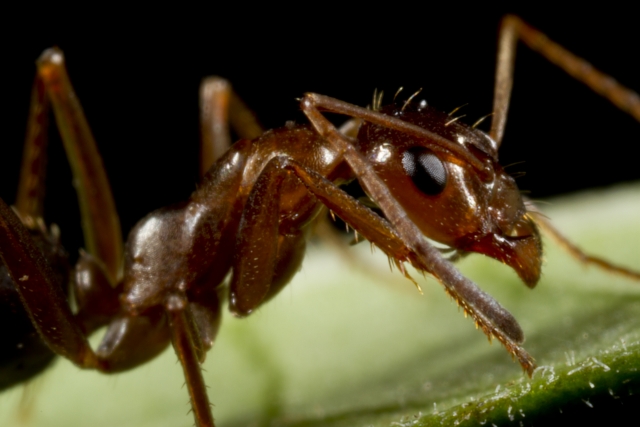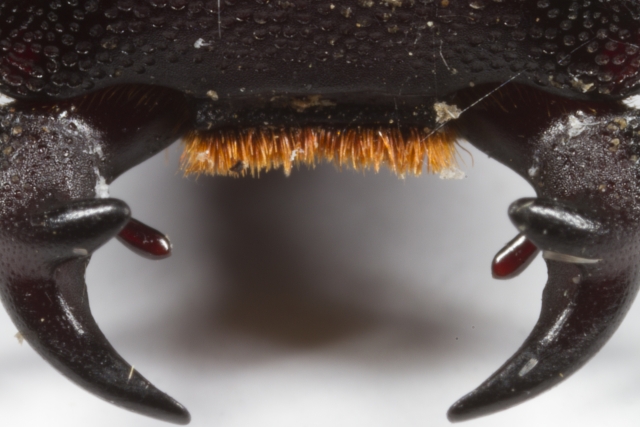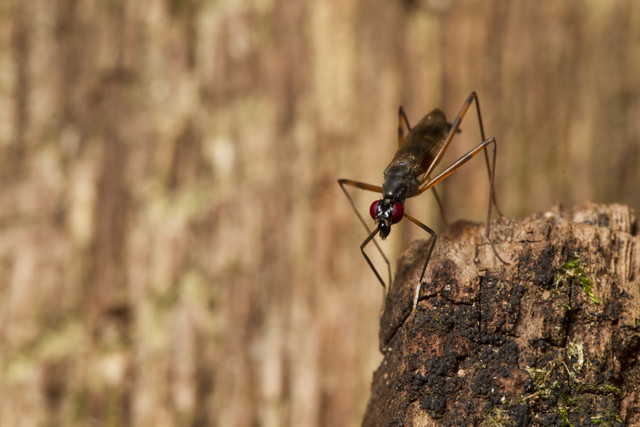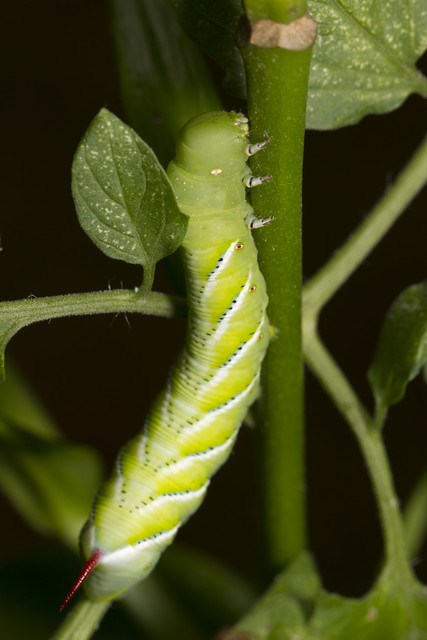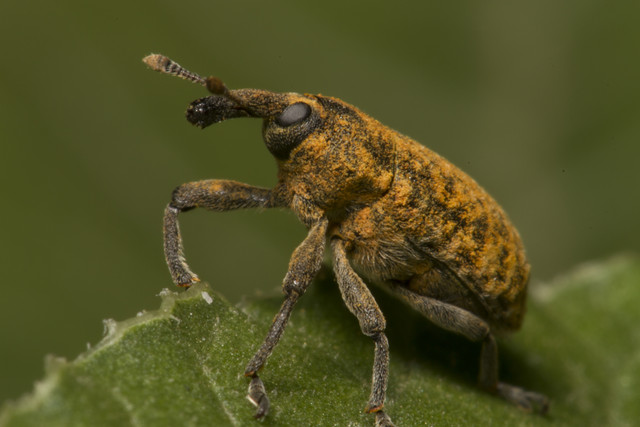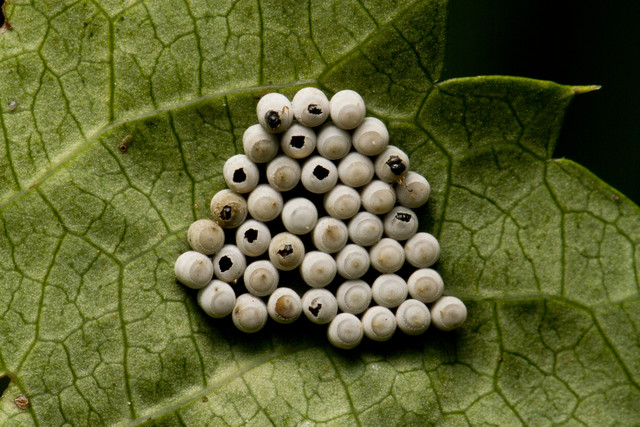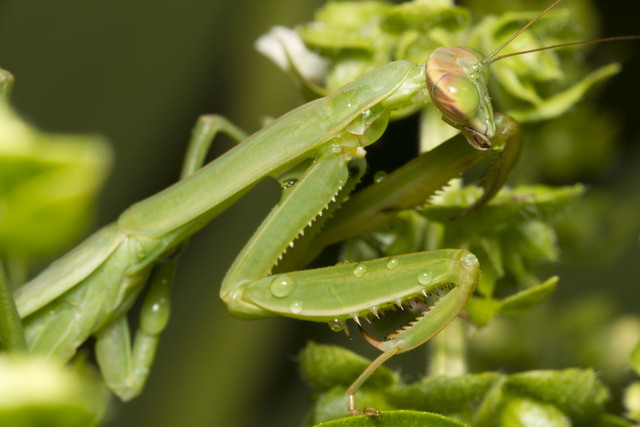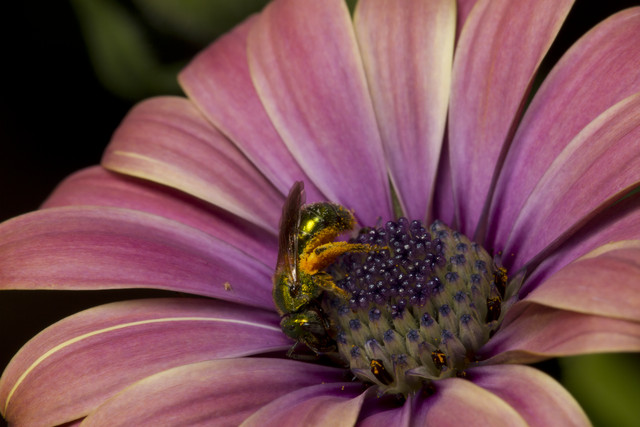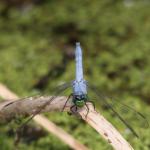insects
Pseudoscorpion
ktuli — Tue, 01/21/2014 - 20:34
Believe it or not, this thing is real...
Anya found this on one of our walls, and a quick google search later, turned up that it is called a pseudoscorpion. Like it's namesake, it is in the arachnid family, but obviously is missing the stinger. It is very small, only a few millimeters long. I have a few more shots, but for now I have an episode of Sherlock to watch.
Technical Data: Canon EOS 7D, Canon MP-E 65mm f/2.8 1-5x Macro, 1/200 sec at f/16. Canon Macro Twin Lite MT-24EX in ETTL mode. ISO 100. RAW processing in Adobe Camera Raw.
Stay tuned.
- Bill
Focus Stack: Praying Mantis
ktuli — Mon, 12/17/2012 - 20:20
Yesterday, while walking our dogs, I spotted a dead praying mantis laying in some bushes. Since a live mantis would never sit still for a focus stack process, I decided this was a perfect opportunity to try one, so I picked it up in a plastic bag and carried it home to photograph.
A focus stack is a process of taking multiple photos, each with a slightly different slice of the scene in focus. Once you have all of your slices, you can run it through some software (in my case, I used Zerene Stacker) to align and stack the slices into a super-image with all of the scene in focus. This process is very popular for macro photographers where the depth of field can be very small (even with a small aperture).
This is the first time I've ever tried this, so I don't know if I did things right or not - I pretty much just accepted the defaults and let the software do its thing. Zerene provides two different stacking algorithms - one called DMap and another called PMax - so I tried both to see what results I could get. Here I also provide a single slice for the set to show just how little in focus I was getting for each slice.
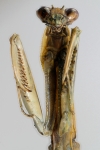 DMap |
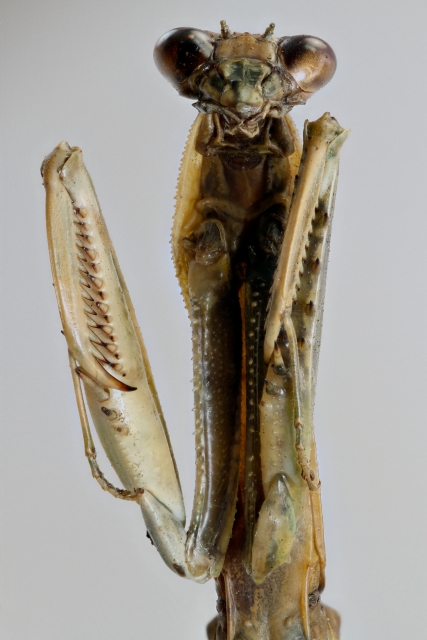 |
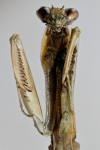 PMax |
|
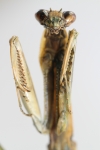 Single Slice |
Technical Data: Canon EOS 7D, Canon EF 100mm f/2.8L Macro IS USM, 1/250 sec at f/5.6. Canon Speedlight 580EX II flash in eTTL mode and wireless control. Image Stabilization off. ISO 640. 22 image stack processed in Zerene Stacker.
As you can see this shot above was done with my 100mm macro lens, but was shot at about 1:1.5 magnification, meaning it is not at lifesize magnification. I had to do this to get the head and forearms in the shot at once. Unfortunately, it wasn't very flexible, so I didn't have much choice on the posing or I would have moved the arm on the right a bit to separate it from the body; however, I was afraid of breaking the arm off, so I didn't try to move it.
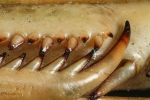 DMap |
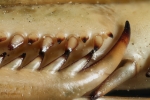 PMax |
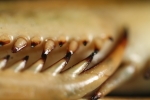 Single Slice |
 |
||
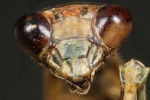 DMap |
 PMax |
 Single Slice |
Technical Data: Canon EOS 7D, Canon MP-E 65mm f/2.8 1-5x Macro, 1/250 sec at f/5.6. Canon Macro Twin Lite MT-24EX in ETTL mode. ISO 100. 17 and 18 image (respectively) stack processed in Zerene Stacker.
As you can see, the DMap method seems to leave some really undesirable artifacts in the final image that look ugly. I'm not sure if that was my fault for not configuring something correctly (or from my old computer not keeping up), or if that method doesn't work well for this kind of shot, or what. I'll have to do more research and see whether I can figure out why that happened.
With the second and third shots, I used the Canon MP-E 65mm macro lens. For the claw, I used a 4x magnification (4:1), and a 2x magnification (2:1) for the face. With the face, I apparently should have taken more shots to get the "neck/shoulders" in focus as well at the bottom of the frame - that was my mistake because I was looking at the top of the mantis' head as I moved the focus forward to get the slices and forgot to look at the rest of the frame.
To take these shots, I had my camera mounted on my macro focusing rail and set the lens in manual focus mode and simply moved the whole rig forward and backwards to get the slices I needed. To be honest, it was a lot of work to setup the shot and make the very small adjustments to get all the necessary slices.
- Bill
Super Macro Ant
ktuli — Mon, 09/17/2012 - 20:33
Ok - a brief break from the Yosemite photos (mainly because I need to process more of them) to share a super macro shot I did of an ant during this past week's MeetUp Macro Shootout that I hosted out at South Park...
Technical Data: Canon EOS 7D, Canon MP-E 65mm f/2.8 1-5x Macro, 1/160 sec at f/16. Canon Macro Twin Lite MT-24EX in ETTL mode. ISO 100. RAW processing in Adobe Camera Raw.
Not necessarily a view you get of an ant every day. I normally can't get shots like this because ants rarely hold still, but it was fairly early and somewhat chilly that morning, so this ant was quite sluggish which allowed me to get several shots of it.
- Bill
Stag Beetle Mandibles
ktuli — Mon, 06/18/2012 - 09:30
Ok - deviating slightly from the spiders today... Here's the business end of a stag beetle (I believe Dorcus parallelipipedus) at probably 4x magnification (I forget exactly).
Technical Data: Canon EOS 7D, Canon MP-E 65mm f/2.8 1-5x Macro, 1/250 sec at f/16. Canon Macro Twin Lite MT-24EX in ETTL mode. ISO 100. RAW processing and cropped in Adobe Camera Raw.
- Bill
Spooky Fly
ktuli — Mon, 09/12/2011 - 19:26
Another thing I spotted when we were out on our little hike at Round Hill Park (see yesterday's post) was this fly.
I have no idea on the species, but if the government is going to make spy bugs or if an alien race of space bugs invades, this is what I would expect them to look like....
Technical Data: Canon EOS 7D, Canon EF 100mm f/2.8L Macro IS USM, 1/200 sec at f/16. Canon Speedlight 580EX II flash in auto mode and wireless control. Image Stabilization on. ISO 100. RAW processing in Adobe Camera Raw. Round Hill Park, Elizabeth, PA.
I only got off one shot of this guy as it struck this pose, but those huge red eyes just screamed out to me and I got in as close as I could and fired off a single shot before it flew away and I couldn't find it again.
... probably to report back to the mothership.
- Bill
Sphinx Caterpillar
ktuli — Thu, 09/08/2011 - 18:40
I am not 100% certain on the species of this caterpillar, but I am pretty sure it is in the Ceratomia family. This is a group of sphinx hawkmoths.
The species I am leaning towards most with this individual is the Waved Sphinx (Ceratomia undulosa).
This is the moth of Silence of the Lambs fame.
My doubt on the identification comes from the lack of the white stripe on the face of the caterpillar, and the reddish color to the tail spike/horn. But everything else is spot on and I haven't been able to find another species that would fit better.
Technical Data: Canon EOS 7D, Canon EF 100mm f/2.8L Macro IS USM, 1/100 sec at f/8. Canon Speedlight 580EX II flash in auto mode and wireless control. Image Stabilization on. ISO 100. RAW processing in Adobe Camera Raw.
I probably should have went for more depth of field with a smaller aperture, but I was trying to also keep the background from being pitch black (though even that didn't work out so well). As a result, the head of the caterpillar is in clarity while the tail starts to blur out a bit.
I have a couple other angles to share eventually, but while you'd probably expect a caterpillar to be an easy subject to work with, it was actually very difficult to get it to move into good positions, and to stay still once there. As with all caterpillars, they only have six true legs (seen here colored white) and the rest are merely fleshy apendages that have sticky pads on the end of them - making them very difficult to detach unless they want to.
A challenging, yet very cool subject.
- Bill
Boll Weevil
ktuli — Wed, 09/07/2011 - 17:59
Been having a hard time coming up with things to write about, so just going to share another photo today. Our subject for this one is a boll weevil of some sort.
Technical Data: Canon EOS 7D, Canon EF 100mm f/2.8L Macro IS USM with Kenko Teleplus PRO 300 "DG" AF 2x Teleconverter, 1/250 sec at f/16. Canon Speedlight 580EX II flash in auto mode and wireless control. Image Stabilization on. ISO 100. RAW processing in Adobe Camera Raw.
- Bill
Hatching Wasp Eggs
ktuli — Wed, 08/31/2011 - 20:44
I have to admit something about this photo - when I took it, I didn't even notice the fact that these eggs were hatching. In all fairness, they are only about 1mm in size, so they were pretty tiny.
Anyway, I happened to catch a glimpse of these white eggs attached to the underside of a leaf, so while I held the lead over with one hand, I had to steady the camera and shoot with the other. Not necessarily the easiest thing to do. Add in that the bright sun was wreaking havoc with my wireless flash capabilities (I need to remember to keep my sync cord with me for cases like that).
However, once I got home and looked at these on the computer, I realized that the wasps were actually in the process of hatching right then! Had I realized that at the time, I most certainly would have taken much more time with this subject and used the 2x teleconverter to get some even closer detail. As it is, you'll have to settle for a crop (mouseover the image for the cropped view).
Technical Data: Canon EOS 7D, Canon EF 100mm f/2.8L Macro IS USM, 1/250 sec at f/16. Canon Speedlight 580EX II flash in auto mode and wireless control. Image Stabilization on. ISO 160. RAW processing and cropped in Adobe Camera Raw.
Due to the bright sunlight, I don't think the flash actually fired, so I had to do some significant brightening of this in post production, and because of my less than recommended one-handed camera stabilizing techniques, there is a bit of camera shake blur that the IS wasn't able to fix (normally 1/250th a second wouldn't be a problem to hand hold, but with the flash bracket and one-handed operation, apparently that isn't the case).
Regardless, I thought the original image was interesting because of the beautiful pattern the eggs create, but finding the bonus of the wasps actually hatching is really really cool if you ask me.
- Bill
Formidable Weapons
ktuli — Tue, 08/16/2011 - 20:08
Just a quick post today, showing a less playful side to the mantis that played peek-a-boo...
Technical Data: Canon EOS 7D, Canon EF 100mm f/2.8L Macro IS USM, 1/250 sec at f/16. Canon Speedlight 580EX II flash in auto mode and wireless control. Image Stabilization on. ISO 100. RAW processing in Adobe Camera Raw.
- Bill
Pollen Covered Sweat Bee
ktuli — Thu, 08/11/2011 - 20:44
Ok - sorry, just doing another very quick post today...
Technical Data: Canon EOS 7D, Canon EF 100mm f/2.8L Macro IS USM, 1/250 sec at f/16. Canon Speedlight 580EX II flash in auto mode and wireless control. Image Stabilization on. ISO 100. RAW processing and cropped in Adobe Camera Raw.
This is a green sweat bee (Agapostemon texanus) - for obvious reasons... well, at least the green part. I was quite happy that the shot captured the metallic qualities of this bee, and I was just drawn to the shot because of all that pollen covering its legs.
Thanks for stopping by.
- Bill


